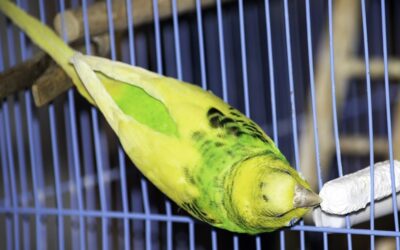We’d like to see the individual capable of resisting this teeny tiny parrot’s huge charm! The Pacific parrotlet is truly pocket-sized (smaller than a budgie), but make no mistake. These birds guys have huge personalities and make a great addition to your family if you’re looking for some life in the home. Don’t forget, though: all parrots require specific care and lots of attention.
Let’s go into Pacific parrotlet care, whether this is the right parrot for you, and how to keep your new feathered friend happy and healthy in your home.
| Name(s) (common, scientific) | Pacific parrotlet, celestial parrotlet, Forpus coelestis |
| Natural habitat | Western Ecuador and Peru |
| Adult size | 25-30 grams, up to 14cm/5.5″ |
| Lifespan | 15+ years |
| Noise level | Low (for a parrot) |
Pacific parrotlet appearance & natural habitat
Appearance
The Pacific parrotlet is one of the smallest parrot species in the world. At a maximum weight of 30 grams and a maximum length of 5.5″, they’re actually smaller than the tiny budgerigar! Talk about a pocket rocket parrot. The species sports a short tail and relatively compact, stocky body.
Pacific parrotlets have been selectively bred into a range of different colors. Naturally, they are green, but blue specimens are very common in captivity. You can also find them in yellow, white, grey, and more colors. The hooked beak is always horn-colored, while the eyes are black and surrounded by a narrow bare ring.
Did you know? Pacific parrotlets are sexually dimorphic. This means that it’s usually possible to visually tell whether they’re male or female, making it easier to find pairs. Males sport blue shadow behind the eyes, on part of the back and on the wing tips.
Natural habitat
The Pacific parrotlet is a neotropical parrot, which means it’s naturally found in South America. Specifically, this species’ natural range extends from northwestern Peru to western Ecuador. These areas border the Pacific coast, hence the species’ common name. A flock has also been spotted as far north as Colombia.
Pacific parrotlets aren’t too specific about their preferred habitat. Flocks of up to 50 birds inhabit both drier and more humid forested regions. Although some of these areas have been affected by deforestation, this hasn’t affected the populations too much. Pacific parrotlets are still listed as Least Concern by the IUCN.

Pacific parrotlet diet
Wild diet
It’s a bit difficult to find adequate information on wild parrotlet diet, although we know that like all parrots, they’re omnivores that lean towards herbivory. Sources generally report their diet is seed-based, possibly with a preference for spiny amaranth. They’re also noted to consume berries, fruits (notably cactus and tamarind), and possibly the occasional insect.
Pacific parrotlets can be seen foraging both in the trees and on the ground. They may also visit clay licks, where they eat soil in order to obtain nutrients they can’t get from their normal diet.
Domestic diet
As with all pets (and humans), the key to a healthy parrotlet diet is variety. The classic parrot seed mix isn’t gonna cut it, especially if it’s high in sunflower seeds: it’s too fatty and not nutrient-dense enough. Formulated parrot pellets are a much better choice, but they shouldn’t be the only thing your bird eats either.
A proper diet is crucial when it comes to keeping your parrotlet happy and healthy. Low-quality foods increase the risk of obesity and malnutrition, so go for lots of fresh and nutritious options!
You could try a mix of the following, for example:
- A high-quality small parrot pellet
- A high-quality small parrot seed mix
- Fresh vegetables and leafy greens daily
- Sprouted seeds
- Fruit (once in a while, due to the sugar content)
- Treats (for training, for example): millet, sunflower seeds, pieces of nut
Other things you can feed occasionally include some boiled egg, foraged pesticide-free weeds like dandelion leaf, and parrot-safe branches with fresh shoots or flowers. Remember to always leave fresh water available, preferably from multiple sources.
Tip: Avoid just throwing some food into a bowl for your parrotlet to gobble up. Offering part of its daily food in a foraging setting helps keep your bird’s smart brain stimulated!

Pacific parrotlet temperament
This is definitely a section you don’t want to skip when researching Pacific parrotlets. Although these birds are truly tiny, they are very feisty. In terms of personality, they can easily be compared to their larger Amazon parrot cousins. Parrotlets can be very affectionate towards their owners, and a well-socialized bird will often love to ride on your shoulder, receive neck scratches, or doze on your knee while you watch TV.
These parrots, like the other members of their family, are also very intelligent and receptive to learning tricks. Check out the tricks of the legendary Charlie the Parrotlet (RIP) on Instagram to see what we mean! You do need to keep up with your parrotlet’s training, as they can become bitey when untamed. Those tiny beaks are surprisingly powerful and can draw blood.
Pacific parrotlets are not known for being the best cage mates. They can be territorial and even downright aggressive, picking fights with birds and other creatures much larger than them. As such, they’re not a great choice for a mixed aviary: if you’d like to get some company for your parrotlet, it’s often best to just find it a mate belonging to its own species. Why not try quail for your aviary instead?
Pacific parrotlet housing
A Pacific parrotlet might be a tiny creature, but these birds are highly active, so don’t think you can get away with providing a small cage. They need space! The minimum mentioned by many sources is 18″ x 18″, but this is really only acceptable if your bird will be spending almost all day outside.
Something at least 30″ x 18″ seems like a much better place to start. Cage height is less important than cage length, as parrots mostly use the top area. The bar spacing on the cage should be about 1/2″ (1.3 cm) maximum: Pacific parrotlets are very small and can get their heads stuck in cages with larger bar spacing.
You’re not quite there yet with just the cage. As discussed below, having plenty of toys available is very important for any species of parrot. Additionally, you should provide multiple natural (wooden) perches and multiple food and water stations.

Pacific parrotlet enrichment
As we’ve mentioned, although they’re small, Pacific parrotlets are very intelligent and curious. In the wild, they spend much of their day foraging, figuring out how to find food and interacting with their mate and other flock members. In the home, you need to provide plenty of enrichment. A bored and understimulated parrotlet is prone to issues like feather plucking, excessive vocalization, and aggression.
So what can you do to make sure your Pacific parrotlet stays entertained? Luckily, you’ve got loads of options:
- Toys, toys, toys! There are loads of different types of parrot toys suitable for small birds like these. You can even make them yourself, or collect some chewable parrot-safe branches outdoors. Just be sure to rotate toys regularly to keep them exciting, and remove any that are starting to fall apart (for safety reasons).
- Foraging. Use foraging toys or make a nice foraging box for your parrotlet to dig around in. Even serving veggies whole rather than chopped can keep a parrot busy for ages, just as it would spend time gathering its meals in the wild.
- Training. Such a good one! Spending some time daily training your parrotlet stimulates its smart brain, strengthens your bond and helps teach it desirable behaviors. Try useful behaviors like stepping up, tricks, or talking training.
- Out of cage time. Unless you have a very large flight cage, your parrotlet should spend at least a few hours a day roaming around a parrot-proofed room. This allows it to explore and exercise, helping to avoid obesity. It can be helpful to have a parrot playground or tree on top of the cage or wherever suits you.
- Social interaction. We can’t stress it enough: you either need to have your parrotlet around you for most of the day (training, playing or simply hanging out), or it needs a friend/mate. They become absolutely miserable without enough attention, like in the case of solo birds whose owners work regular 9-5 jobs.
Pacific parrotlet sounds
If you’re looking to add a parrot to your family, you should research whether the species you’re interested in is known for being loud. Many are known for being extremely noisy! Luckily, parrotlets are generally suitable for apartment living. This species isn’t silent by any means—no parrot is—but it is among the quietest of its family. Expect to hear lots of quiet peeps and tiny screams throughout the day.
These parrotlets can also learn to talk! Although they’re no African greys or Amazon parrots, some are definitely talented little mimics. They can learn to imitate noises, words, tunes and even short phrases. There’s no guarantee that yours will learn, as some just never pick it up, but talking training is always worth a shot. Our birds just love being babbled to even if they don’t imitate thwat they hear.
To start talking training, take your parrotlet to a quiet spot and just start repeating! Be sure to have a treat ready to reward a job well done.
Pacific parrotlet safety & emergencies
If you’re a parrot owner, you should have the number for an avian vet in your phone or on the fridge. No exceptions! The tiny parrotlet is extremely inquisitive and can easily get itself in trouble. You’ll definitely have to check each time before plopping down on the couch, for example.
Any room that your parrotlet has access to should be parrot-proofed, meaning free of unsafe elements like ceiling fans, toxic houseplants, open doors and windows, fumes, and more. You should also read up on the basics of parrot emergency care, like how to stop bleeding or recognize a sick bird.

Frequently asked questions
How long do Pacific parrotlets live?
The potential lifespan of any parrot depends largely on luck and how well the bird is cared for. With the right care, a Pacific parrotlet could live for 15 to 20 years. Adding one to your family is quite the commitment!
Why do parrotlets wiggle?
The parrotlet wiggle is one of our favorite things about these tiny parrots! Although they can do it whenever they’re happy, it’s usually part of courtship, and they may regurgitate food in the process. As such, as cute as it is, it’s best to ignore this behavior in order to prevent your bird from getting overly hormonal.
Conclusion
Pacific parrotlets can make great pets for folks looking for big parrot personality, but in a small package. Do keep in mind that parrots are high-maintenance pets that need a lot of attention; don’t get one unless you’re sure you’re willing to care for the tiny equivalent of a toddler for up to 20 years!
Going on holiday and need someone to keep your Pacific parrotlet or other type of parrot company? That’s where Kate’s K9 Pet Care comes in: we’re the #1 pet care center in Maryland and Virginia. Sign up to find your perfect pet care service, from pet sitting to feeding and much more.
Sources & further reading Brinkhuisen, D. M., & Semola, T. (2014). First record of Pacific Parrotlet Forpus coelestis in Colombia. Conservación Colombiana, 21, 30-32.







